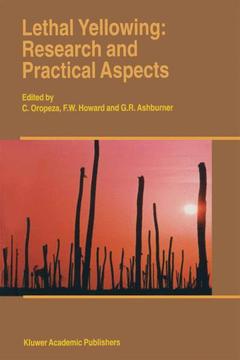Description
Lethal Yellowing: Research and Practical Aspects, Softcover reprint of the original 1st ed. 1995
Developments in Plant Pathology Series, Vol. 5
Coordinators: Oropeza C., Howard F.W., Ashburner G.R.
Language: English
Subjects for Lethal Yellowing: Research and Practical Aspects:
Keywords
Publication date: 10-2012
252 p. · 16x24 cm · Paperback
252 p. · 16x24 cm · Paperback
Description
/li>Contents
/li>Comment
/li>
When I received an invitation to attend the International Symposium on Lethal Yellowing being organised by the Centro de Investigacion Cientifica de Yucatan (CICy), I was excited and a little nostalgic. During the 1970s, a series of similar symposia had been held under the auspices of the loosely-constituted "International Council on Lethal Yellowing" (ICL Y). These were the years when the MLO cause for L Y was first proposed, a vector was found, the disease was racing across mainland Florida, USA and it was suspected of having jumped to Cozumel. Analogous diseases were also reported to be spreading in Africa and elsewhere. The ICL Y meetings, held approximately every two years, proved to be an immensely valuable forum for all involved in the research and control of L Y. They attracted a very wide cross-section of scientists and practitioners working on L Y, on related diseases, and on palms in general. Many participants of those ICL Y meetings also attended this CICY Symposium. Unfortunately, during the 1980s, as countries learned to live with L Y, most of the national and international funding for L Y research dried up, and so did ICL Y. The present symposium is the only international meeting to have been devoted to L Y since the last meeting of rCLY in 1979. Its convening in Merida is timely.
Brief: Foreword. Introduction. Part 1: Introduction to lethal yellowing. Part 2: Aspects of the disease. Part 3: Diagnosis and detection. Part 4: Control of lethal yellowing. Part 5: Genetic resources and improvement. Part 6: In vitro tissue culture. Part 7: Future directions for the coconut industry. Index.
This book deals with the most severe of the diseases, lethal yellowing, which has killed millions of coconut palms in Latin America and the Caribbean alone and which, together with related diseases in Africa and possibly India and Southeast Asia, poses a world-wide threat to coconut production. The papers were presented to a symposium held in Mexico in November 1993. The book will help to maintain the current momentum in lethal yellowing research, stimulating further research on coconut palms, an orphan crop having thousands of uses.
© 2024 LAVOISIER S.A.S.



